Literature Review: Music Therapy's Impact on Dementia Patients
VerifiedAdded on 2022/08/21
|11
|2675
|9
Essay
AI Summary
This essay presents a literature review investigating the efficacy of music therapy in enhancing the quality of life for dementia patients. The review begins with an introduction to dementia, its global prevalence, and the significance of non-pharmacological interventions. It then describes the search strategy used, focusing on PubMed and the PICO framework to identify relevant articles. The selected article, a randomized controlled trial, is critically appraised, examining its methodology, findings, and limitations. The study compared the effects of a music therapy-singing group with a control group, revealing improvements in affect and quality of life for the music therapy group. The essay concludes by highlighting the importance of information literacy in healthcare research and the potential benefits of music therapy in dementia care, emphasizing the need for further research and implementation of non-pharmacological approaches to manage the disease.
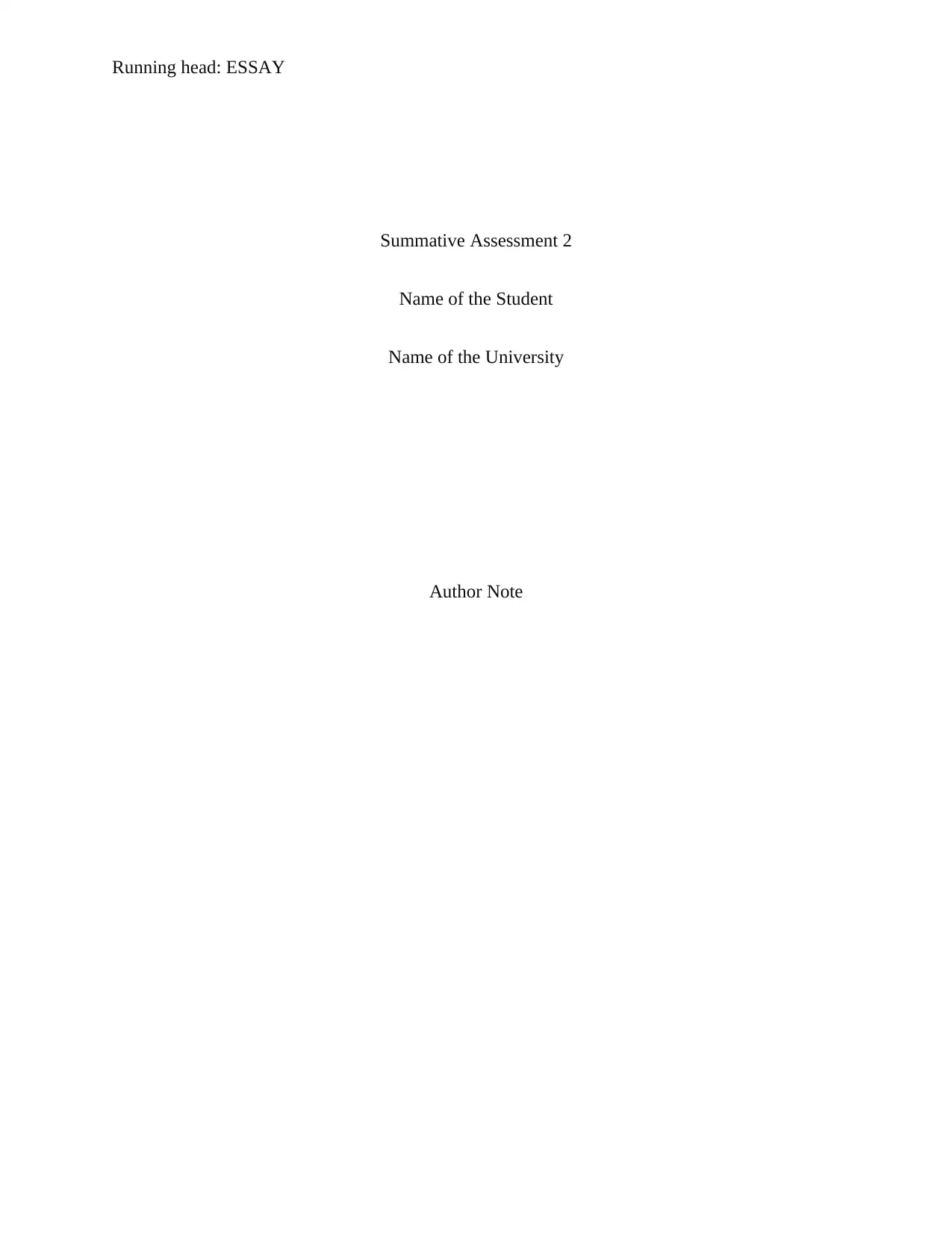
Running head: ESSAY
Summative Assessment 2
Name of the Student
Name of the University
Author Note
Summative Assessment 2
Name of the Student
Name of the University
Author Note
Paraphrase This Document
Need a fresh take? Get an instant paraphrase of this document with our AI Paraphraser
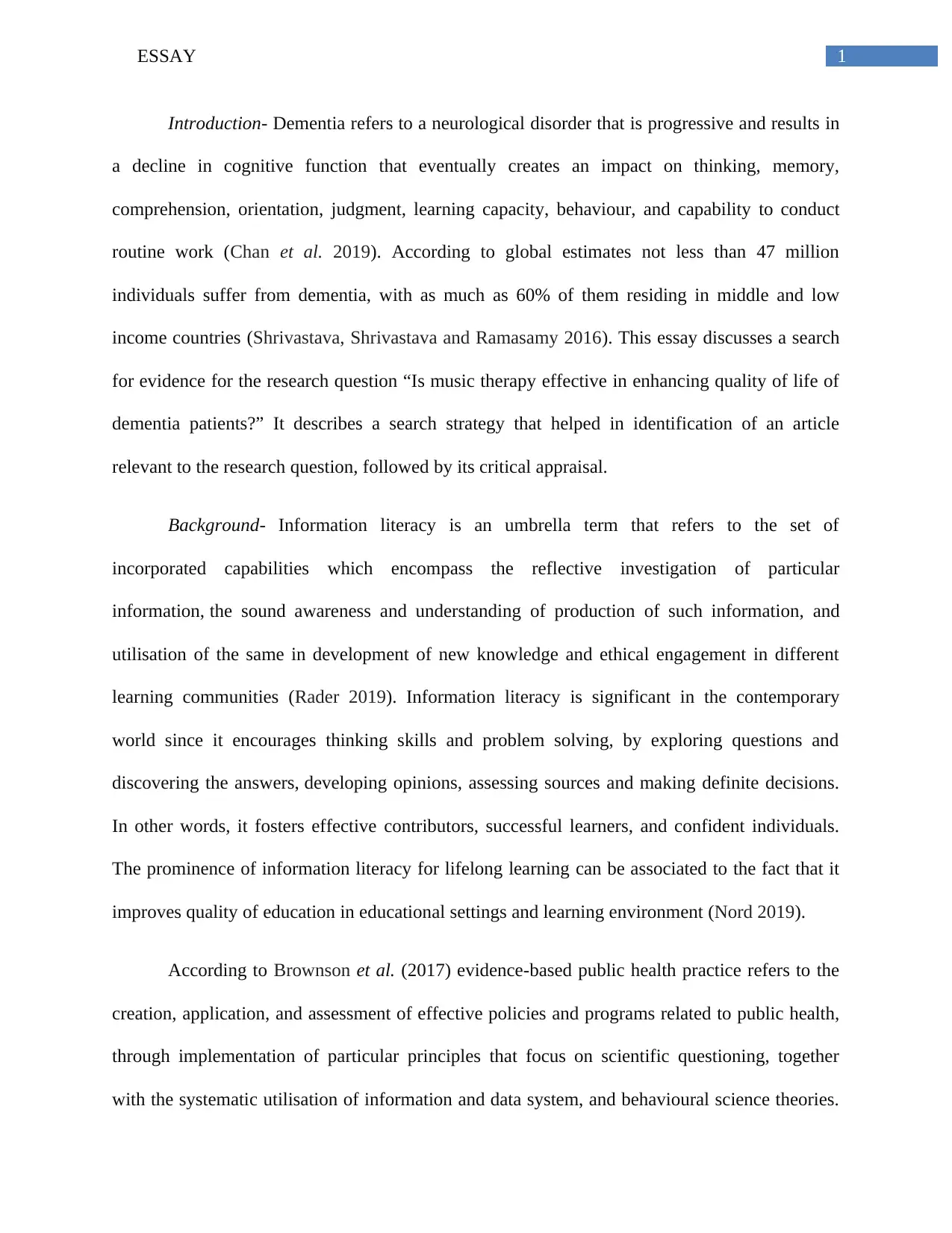
1ESSAY
Introduction- Dementia refers to a neurological disorder that is progressive and results in
a decline in cognitive function that eventually creates an impact on thinking, memory,
comprehension, orientation, judgment, learning capacity, behaviour, and capability to conduct
routine work (Chan et al. 2019). According to global estimates not less than 47 million
individuals suffer from dementia, with as much as 60% of them residing in middle and low
income countries (Shrivastava, Shrivastava and Ramasamy 2016). This essay discusses a search
for evidence for the research question “Is music therapy effective in enhancing quality of life of
dementia patients?” It describes a search strategy that helped in identification of an article
relevant to the research question, followed by its critical appraisal.
Background- Information literacy is an umbrella term that refers to the set of
incorporated capabilities which encompass the reflective investigation of particular
information, the sound awareness and understanding of production of such information, and
utilisation of the same in development of new knowledge and ethical engagement in different
learning communities (Rader 2019). Information literacy is significant in the contemporary
world since it encourages thinking skills and problem solving, by exploring questions and
discovering the answers, developing opinions, assessing sources and making definite decisions.
In other words, it fosters effective contributors, successful learners, and confident individuals.
The prominence of information literacy for lifelong learning can be associated to the fact that it
improves quality of education in educational settings and learning environment (Nord 2019).
According to Brownson et al. (2017) evidence-based public health practice refers to the
creation, application, and assessment of effective policies and programs related to public health,
through implementation of particular principles that focus on scientific questioning, together
with the systematic utilisation of information and data system, and behavioural science theories.
Introduction- Dementia refers to a neurological disorder that is progressive and results in
a decline in cognitive function that eventually creates an impact on thinking, memory,
comprehension, orientation, judgment, learning capacity, behaviour, and capability to conduct
routine work (Chan et al. 2019). According to global estimates not less than 47 million
individuals suffer from dementia, with as much as 60% of them residing in middle and low
income countries (Shrivastava, Shrivastava and Ramasamy 2016). This essay discusses a search
for evidence for the research question “Is music therapy effective in enhancing quality of life of
dementia patients?” It describes a search strategy that helped in identification of an article
relevant to the research question, followed by its critical appraisal.
Background- Information literacy is an umbrella term that refers to the set of
incorporated capabilities which encompass the reflective investigation of particular
information, the sound awareness and understanding of production of such information, and
utilisation of the same in development of new knowledge and ethical engagement in different
learning communities (Rader 2019). Information literacy is significant in the contemporary
world since it encourages thinking skills and problem solving, by exploring questions and
discovering the answers, developing opinions, assessing sources and making definite decisions.
In other words, it fosters effective contributors, successful learners, and confident individuals.
The prominence of information literacy for lifelong learning can be associated to the fact that it
improves quality of education in educational settings and learning environment (Nord 2019).
According to Brownson et al. (2017) evidence-based public health practice refers to the
creation, application, and assessment of effective policies and programs related to public health,
through implementation of particular principles that focus on scientific questioning, together
with the systematic utilisation of information and data system, and behavioural science theories.
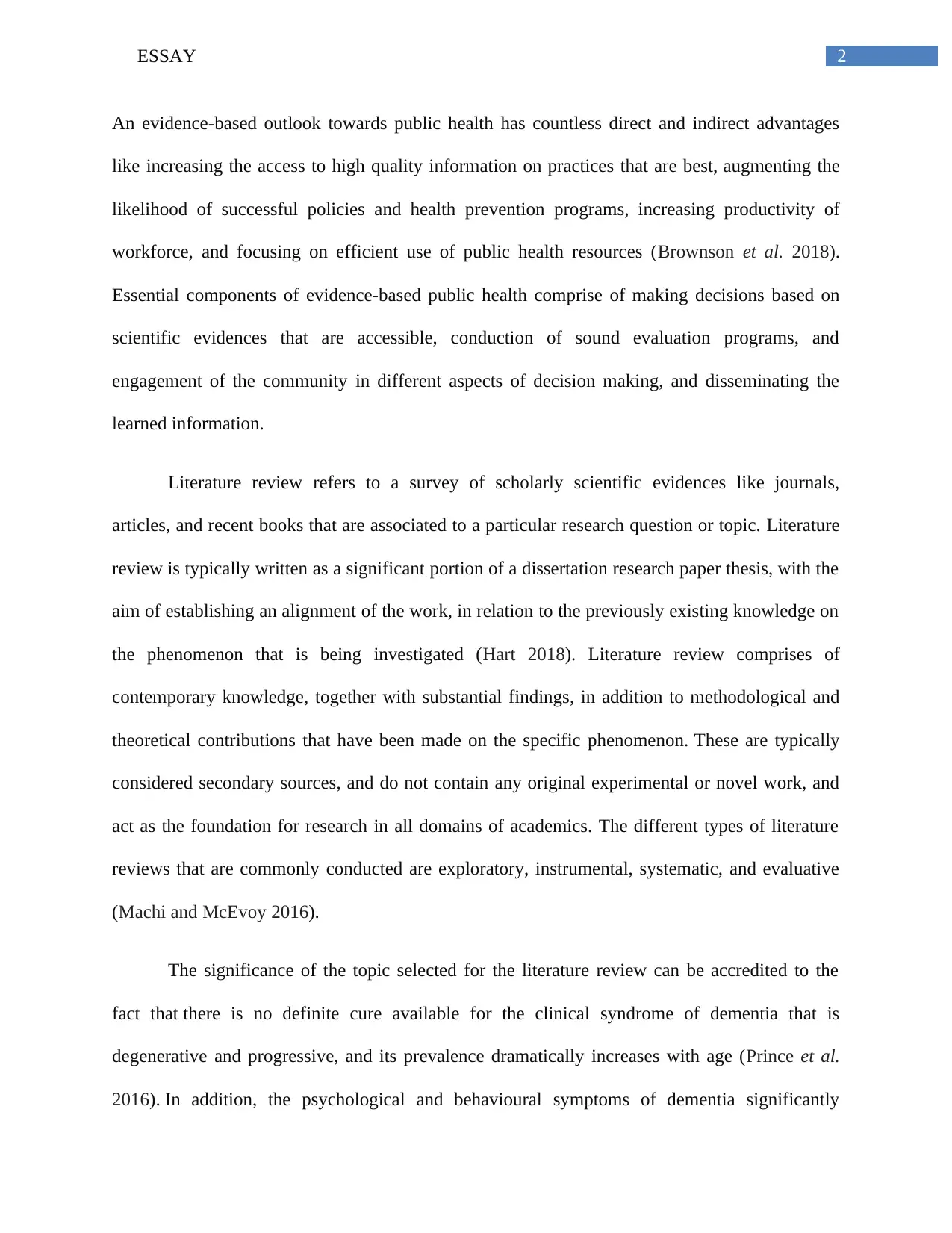
2ESSAY
An evidence-based outlook towards public health has countless direct and indirect advantages
like increasing the access to high quality information on practices that are best, augmenting the
likelihood of successful policies and health prevention programs, increasing productivity of
workforce, and focusing on efficient use of public health resources (Brownson et al. 2018).
Essential components of evidence-based public health comprise of making decisions based on
scientific evidences that are accessible, conduction of sound evaluation programs, and
engagement of the community in different aspects of decision making, and disseminating the
learned information.
Literature review refers to a survey of scholarly scientific evidences like journals,
articles, and recent books that are associated to a particular research question or topic. Literature
review is typically written as a significant portion of a dissertation research paper thesis, with the
aim of establishing an alignment of the work, in relation to the previously existing knowledge on
the phenomenon that is being investigated (Hart 2018). Literature review comprises of
contemporary knowledge, together with substantial findings, in addition to methodological and
theoretical contributions that have been made on the specific phenomenon. These are typically
considered secondary sources, and do not contain any original experimental or novel work, and
act as the foundation for research in all domains of academics. The different types of literature
reviews that are commonly conducted are exploratory, instrumental, systematic, and evaluative
(Machi and McEvoy 2016).
The significance of the topic selected for the literature review can be accredited to the
fact that there is no definite cure available for the clinical syndrome of dementia that is
degenerative and progressive, and its prevalence dramatically increases with age (Prince et al.
2016). In addition, the psychological and behavioural symptoms of dementia significantly
An evidence-based outlook towards public health has countless direct and indirect advantages
like increasing the access to high quality information on practices that are best, augmenting the
likelihood of successful policies and health prevention programs, increasing productivity of
workforce, and focusing on efficient use of public health resources (Brownson et al. 2018).
Essential components of evidence-based public health comprise of making decisions based on
scientific evidences that are accessible, conduction of sound evaluation programs, and
engagement of the community in different aspects of decision making, and disseminating the
learned information.
Literature review refers to a survey of scholarly scientific evidences like journals,
articles, and recent books that are associated to a particular research question or topic. Literature
review is typically written as a significant portion of a dissertation research paper thesis, with the
aim of establishing an alignment of the work, in relation to the previously existing knowledge on
the phenomenon that is being investigated (Hart 2018). Literature review comprises of
contemporary knowledge, together with substantial findings, in addition to methodological and
theoretical contributions that have been made on the specific phenomenon. These are typically
considered secondary sources, and do not contain any original experimental or novel work, and
act as the foundation for research in all domains of academics. The different types of literature
reviews that are commonly conducted are exploratory, instrumental, systematic, and evaluative
(Machi and McEvoy 2016).
The significance of the topic selected for the literature review can be accredited to the
fact that there is no definite cure available for the clinical syndrome of dementia that is
degenerative and progressive, and its prevalence dramatically increases with age (Prince et al.
2016). In addition, the psychological and behavioural symptoms of dementia significantly
⊘ This is a preview!⊘
Do you want full access?
Subscribe today to unlock all pages.

Trusted by 1+ million students worldwide
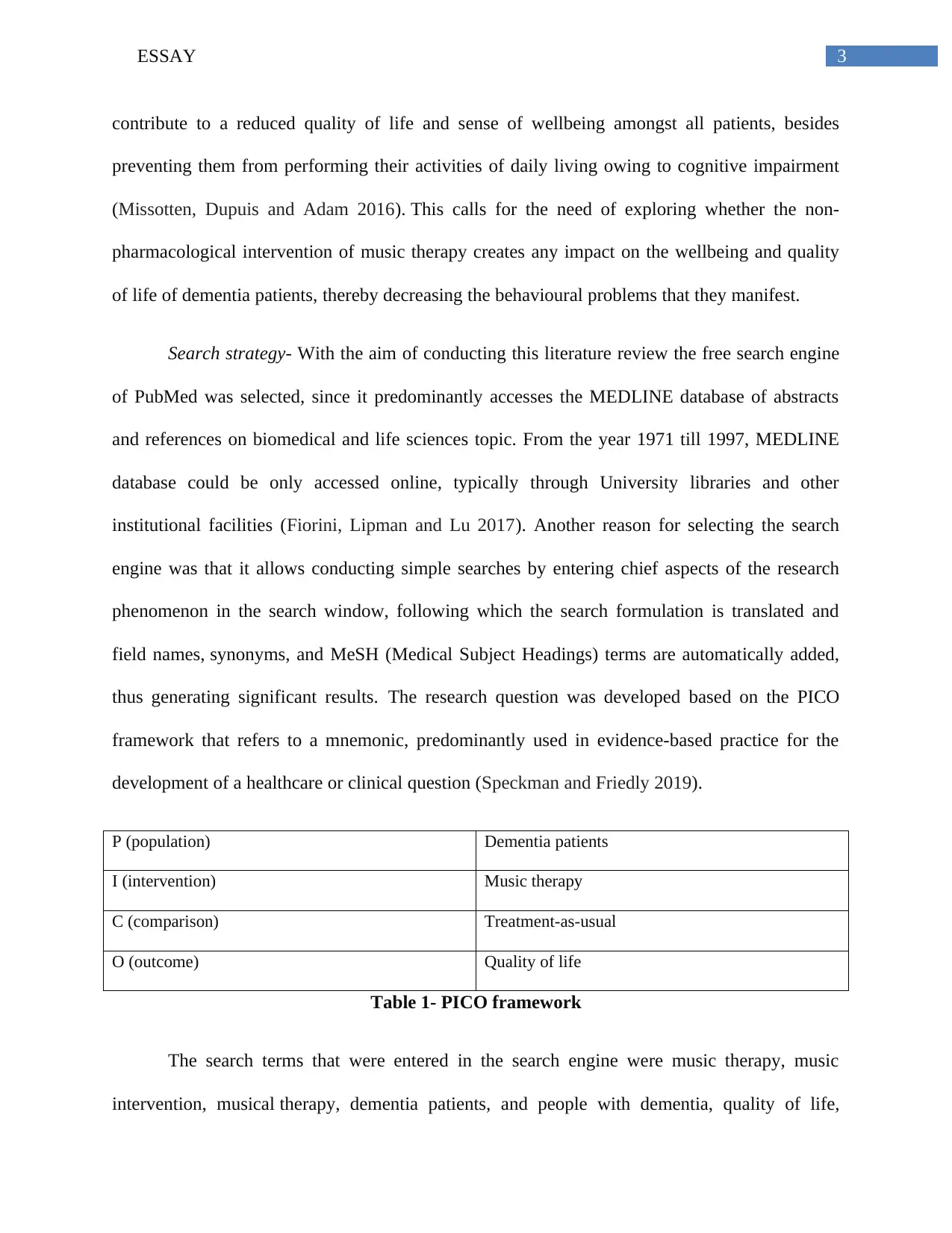
3ESSAY
contribute to a reduced quality of life and sense of wellbeing amongst all patients, besides
preventing them from performing their activities of daily living owing to cognitive impairment
(Missotten, Dupuis and Adam 2016). This calls for the need of exploring whether the non-
pharmacological intervention of music therapy creates any impact on the wellbeing and quality
of life of dementia patients, thereby decreasing the behavioural problems that they manifest.
Search strategy- With the aim of conducting this literature review the free search engine
of PubMed was selected, since it predominantly accesses the MEDLINE database of abstracts
and references on biomedical and life sciences topic. From the year 1971 till 1997, MEDLINE
database could be only accessed online, typically through University libraries and other
institutional facilities (Fiorini, Lipman and Lu 2017). Another reason for selecting the search
engine was that it allows conducting simple searches by entering chief aspects of the research
phenomenon in the search window, following which the search formulation is translated and
field names, synonyms, and MeSH (Medical Subject Headings) terms are automatically added,
thus generating significant results. The research question was developed based on the PICO
framework that refers to a mnemonic, predominantly used in evidence-based practice for the
development of a healthcare or clinical question (Speckman and Friedly 2019).
P (population) Dementia patients
I (intervention) Music therapy
C (comparison) Treatment-as-usual
O (outcome) Quality of life
Table 1- PICO framework
The search terms that were entered in the search engine were music therapy, music
intervention, musical therapy, dementia patients, and people with dementia, quality of life,
contribute to a reduced quality of life and sense of wellbeing amongst all patients, besides
preventing them from performing their activities of daily living owing to cognitive impairment
(Missotten, Dupuis and Adam 2016). This calls for the need of exploring whether the non-
pharmacological intervention of music therapy creates any impact on the wellbeing and quality
of life of dementia patients, thereby decreasing the behavioural problems that they manifest.
Search strategy- With the aim of conducting this literature review the free search engine
of PubMed was selected, since it predominantly accesses the MEDLINE database of abstracts
and references on biomedical and life sciences topic. From the year 1971 till 1997, MEDLINE
database could be only accessed online, typically through University libraries and other
institutional facilities (Fiorini, Lipman and Lu 2017). Another reason for selecting the search
engine was that it allows conducting simple searches by entering chief aspects of the research
phenomenon in the search window, following which the search formulation is translated and
field names, synonyms, and MeSH (Medical Subject Headings) terms are automatically added,
thus generating significant results. The research question was developed based on the PICO
framework that refers to a mnemonic, predominantly used in evidence-based practice for the
development of a healthcare or clinical question (Speckman and Friedly 2019).
P (population) Dementia patients
I (intervention) Music therapy
C (comparison) Treatment-as-usual
O (outcome) Quality of life
Table 1- PICO framework
The search terms that were entered in the search engine were music therapy, music
intervention, musical therapy, dementia patients, and people with dementia, quality of life,
Paraphrase This Document
Need a fresh take? Get an instant paraphrase of this document with our AI Paraphraser
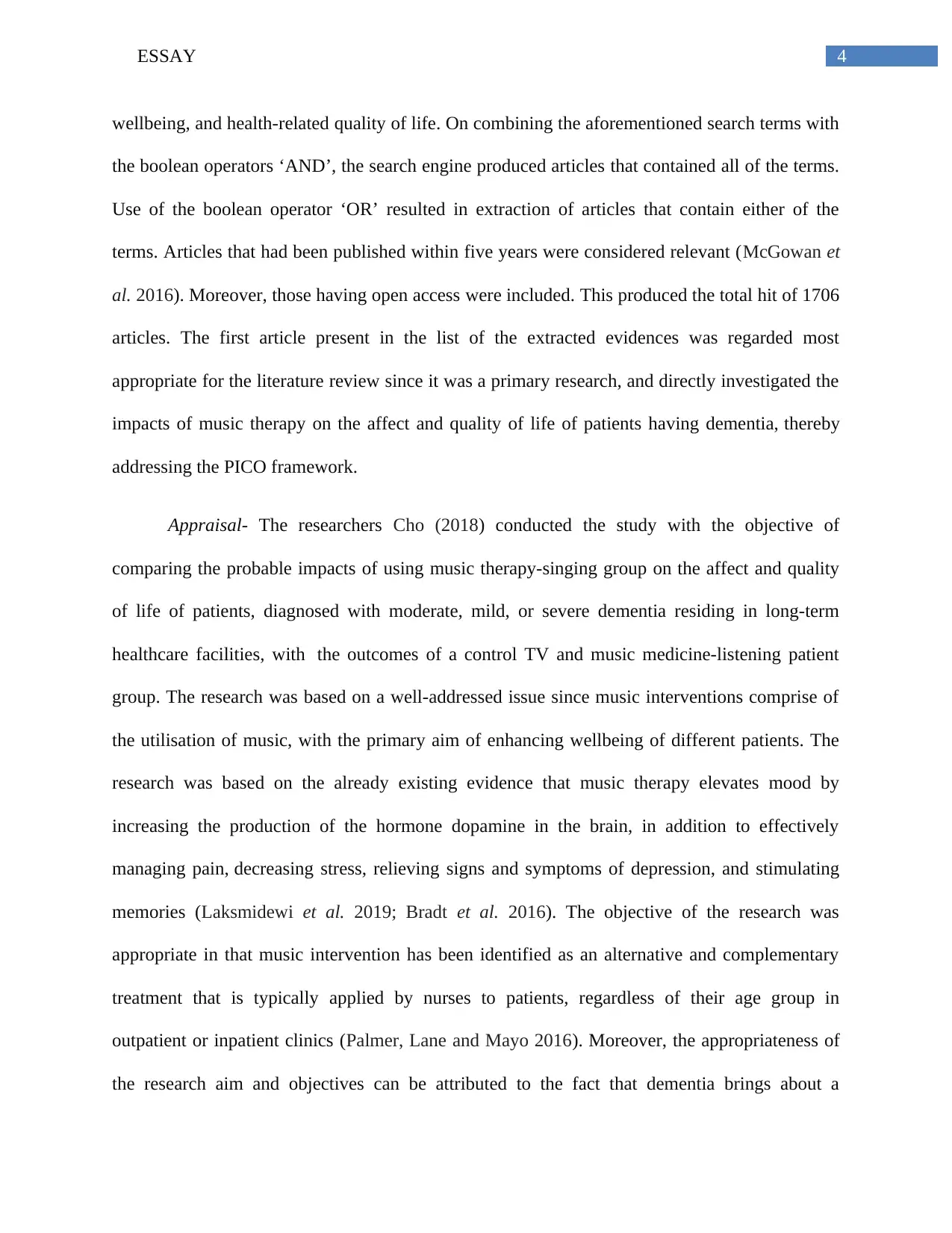
4ESSAY
wellbeing, and health-related quality of life. On combining the aforementioned search terms with
the boolean operators ‘AND’, the search engine produced articles that contained all of the terms.
Use of the boolean operator ‘OR’ resulted in extraction of articles that contain either of the
terms. Articles that had been published within five years were considered relevant (McGowan et
al. 2016). Moreover, those having open access were included. This produced the total hit of 1706
articles. The first article present in the list of the extracted evidences was regarded most
appropriate for the literature review since it was a primary research, and directly investigated the
impacts of music therapy on the affect and quality of life of patients having dementia, thereby
addressing the PICO framework.
Appraisal- The researchers Cho (2018) conducted the study with the objective of
comparing the probable impacts of using music therapy-singing group on the affect and quality
of life of patients, diagnosed with moderate, mild, or severe dementia residing in long-term
healthcare facilities, with the outcomes of a control TV and music medicine-listening patient
group. The research was based on a well-addressed issue since music interventions comprise of
the utilisation of music, with the primary aim of enhancing wellbeing of different patients. The
research was based on the already existing evidence that music therapy elevates mood by
increasing the production of the hormone dopamine in the brain, in addition to effectively
managing pain, decreasing stress, relieving signs and symptoms of depression, and stimulating
memories (Laksmidewi et al. 2019; Bradt et al. 2016). The objective of the research was
appropriate in that music intervention has been identified as an alternative and complementary
treatment that is typically applied by nurses to patients, regardless of their age group in
outpatient or inpatient clinics (Palmer, Lane and Mayo 2016). Moreover, the appropriateness of
the research aim and objectives can be attributed to the fact that dementia brings about a
wellbeing, and health-related quality of life. On combining the aforementioned search terms with
the boolean operators ‘AND’, the search engine produced articles that contained all of the terms.
Use of the boolean operator ‘OR’ resulted in extraction of articles that contain either of the
terms. Articles that had been published within five years were considered relevant (McGowan et
al. 2016). Moreover, those having open access were included. This produced the total hit of 1706
articles. The first article present in the list of the extracted evidences was regarded most
appropriate for the literature review since it was a primary research, and directly investigated the
impacts of music therapy on the affect and quality of life of patients having dementia, thereby
addressing the PICO framework.
Appraisal- The researchers Cho (2018) conducted the study with the objective of
comparing the probable impacts of using music therapy-singing group on the affect and quality
of life of patients, diagnosed with moderate, mild, or severe dementia residing in long-term
healthcare facilities, with the outcomes of a control TV and music medicine-listening patient
group. The research was based on a well-addressed issue since music interventions comprise of
the utilisation of music, with the primary aim of enhancing wellbeing of different patients. The
research was based on the already existing evidence that music therapy elevates mood by
increasing the production of the hormone dopamine in the brain, in addition to effectively
managing pain, decreasing stress, relieving signs and symptoms of depression, and stimulating
memories (Laksmidewi et al. 2019; Bradt et al. 2016). The objective of the research was
appropriate in that music intervention has been identified as an alternative and complementary
treatment that is typically applied by nurses to patients, regardless of their age group in
outpatient or inpatient clinics (Palmer, Lane and Mayo 2016). Moreover, the appropriateness of
the research aim and objectives can be attributed to the fact that dementia brings about a
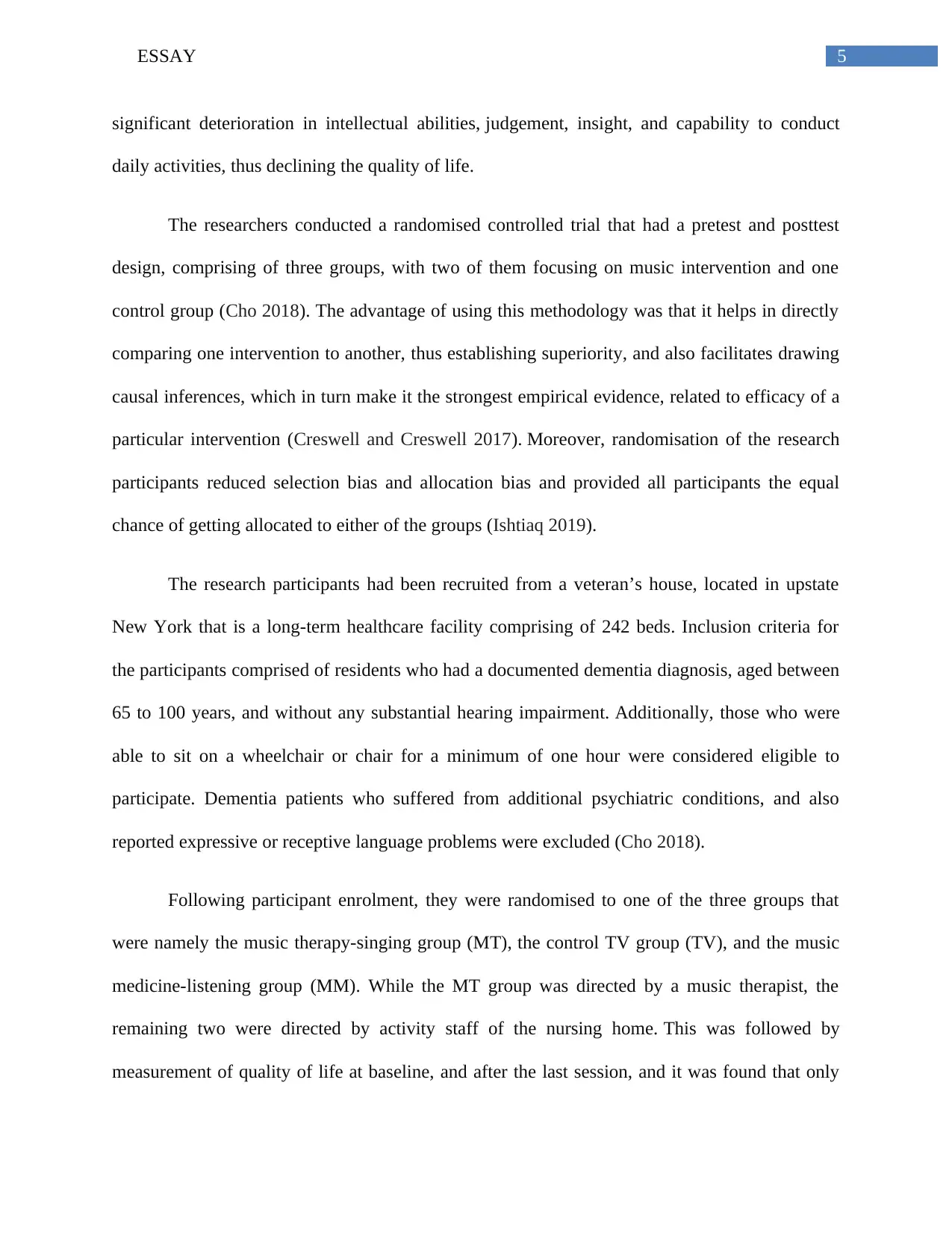
5ESSAY
significant deterioration in intellectual abilities, judgement, insight, and capability to conduct
daily activities, thus declining the quality of life.
The researchers conducted a randomised controlled trial that had a pretest and posttest
design, comprising of three groups, with two of them focusing on music intervention and one
control group (Cho 2018). The advantage of using this methodology was that it helps in directly
comparing one intervention to another, thus establishing superiority, and also facilitates drawing
causal inferences, which in turn make it the strongest empirical evidence, related to efficacy of a
particular intervention (Creswell and Creswell 2017). Moreover, randomisation of the research
participants reduced selection bias and allocation bias and provided all participants the equal
chance of getting allocated to either of the groups (Ishtiaq 2019).
The research participants had been recruited from a veteran’s house, located in upstate
New York that is a long-term healthcare facility comprising of 242 beds. Inclusion criteria for
the participants comprised of residents who had a documented dementia diagnosis, aged between
65 to 100 years, and without any substantial hearing impairment. Additionally, those who were
able to sit on a wheelchair or chair for a minimum of one hour were considered eligible to
participate. Dementia patients who suffered from additional psychiatric conditions, and also
reported expressive or receptive language problems were excluded (Cho 2018).
Following participant enrolment, they were randomised to one of the three groups that
were namely the music therapy-singing group (MT), the control TV group (TV), and the music
medicine-listening group (MM). While the MT group was directed by a music therapist, the
remaining two were directed by activity staff of the nursing home. This was followed by
measurement of quality of life at baseline, and after the last session, and it was found that only
significant deterioration in intellectual abilities, judgement, insight, and capability to conduct
daily activities, thus declining the quality of life.
The researchers conducted a randomised controlled trial that had a pretest and posttest
design, comprising of three groups, with two of them focusing on music intervention and one
control group (Cho 2018). The advantage of using this methodology was that it helps in directly
comparing one intervention to another, thus establishing superiority, and also facilitates drawing
causal inferences, which in turn make it the strongest empirical evidence, related to efficacy of a
particular intervention (Creswell and Creswell 2017). Moreover, randomisation of the research
participants reduced selection bias and allocation bias and provided all participants the equal
chance of getting allocated to either of the groups (Ishtiaq 2019).
The research participants had been recruited from a veteran’s house, located in upstate
New York that is a long-term healthcare facility comprising of 242 beds. Inclusion criteria for
the participants comprised of residents who had a documented dementia diagnosis, aged between
65 to 100 years, and without any substantial hearing impairment. Additionally, those who were
able to sit on a wheelchair or chair for a minimum of one hour were considered eligible to
participate. Dementia patients who suffered from additional psychiatric conditions, and also
reported expressive or receptive language problems were excluded (Cho 2018).
Following participant enrolment, they were randomised to one of the three groups that
were namely the music therapy-singing group (MT), the control TV group (TV), and the music
medicine-listening group (MM). While the MT group was directed by a music therapist, the
remaining two were directed by activity staff of the nursing home. This was followed by
measurement of quality of life at baseline, and after the last session, and it was found that only
⊘ This is a preview!⊘
Do you want full access?
Subscribe today to unlock all pages.

Trusted by 1+ million students worldwide
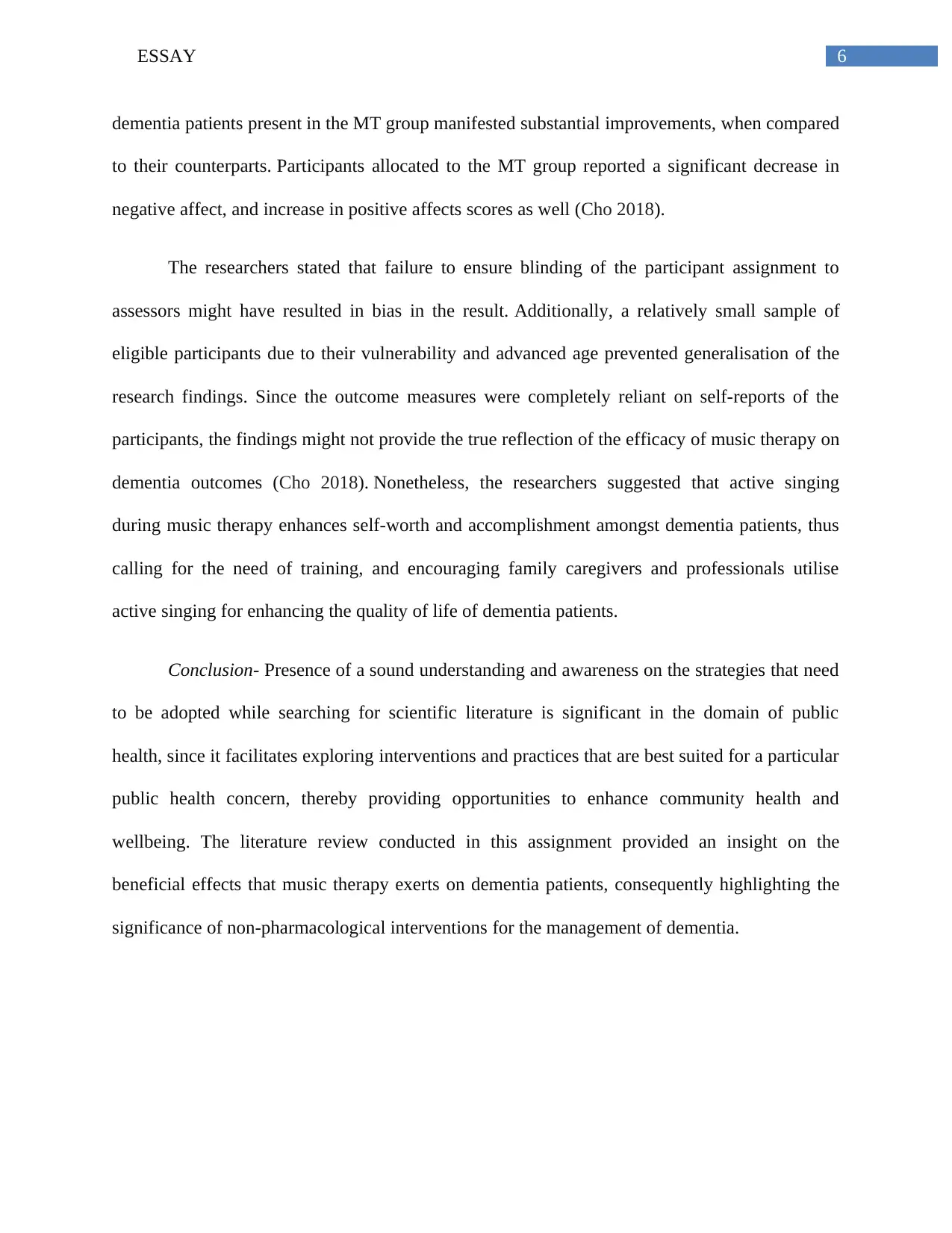
6ESSAY
dementia patients present in the MT group manifested substantial improvements, when compared
to their counterparts. Participants allocated to the MT group reported a significant decrease in
negative affect, and increase in positive affects scores as well (Cho 2018).
The researchers stated that failure to ensure blinding of the participant assignment to
assessors might have resulted in bias in the result. Additionally, a relatively small sample of
eligible participants due to their vulnerability and advanced age prevented generalisation of the
research findings. Since the outcome measures were completely reliant on self-reports of the
participants, the findings might not provide the true reflection of the efficacy of music therapy on
dementia outcomes (Cho 2018). Nonetheless, the researchers suggested that active singing
during music therapy enhances self-worth and accomplishment amongst dementia patients, thus
calling for the need of training, and encouraging family caregivers and professionals utilise
active singing for enhancing the quality of life of dementia patients.
Conclusion- Presence of a sound understanding and awareness on the strategies that need
to be adopted while searching for scientific literature is significant in the domain of public
health, since it facilitates exploring interventions and practices that are best suited for a particular
public health concern, thereby providing opportunities to enhance community health and
wellbeing. The literature review conducted in this assignment provided an insight on the
beneficial effects that music therapy exerts on dementia patients, consequently highlighting the
significance of non-pharmacological interventions for the management of dementia.
dementia patients present in the MT group manifested substantial improvements, when compared
to their counterparts. Participants allocated to the MT group reported a significant decrease in
negative affect, and increase in positive affects scores as well (Cho 2018).
The researchers stated that failure to ensure blinding of the participant assignment to
assessors might have resulted in bias in the result. Additionally, a relatively small sample of
eligible participants due to their vulnerability and advanced age prevented generalisation of the
research findings. Since the outcome measures were completely reliant on self-reports of the
participants, the findings might not provide the true reflection of the efficacy of music therapy on
dementia outcomes (Cho 2018). Nonetheless, the researchers suggested that active singing
during music therapy enhances self-worth and accomplishment amongst dementia patients, thus
calling for the need of training, and encouraging family caregivers and professionals utilise
active singing for enhancing the quality of life of dementia patients.
Conclusion- Presence of a sound understanding and awareness on the strategies that need
to be adopted while searching for scientific literature is significant in the domain of public
health, since it facilitates exploring interventions and practices that are best suited for a particular
public health concern, thereby providing opportunities to enhance community health and
wellbeing. The literature review conducted in this assignment provided an insight on the
beneficial effects that music therapy exerts on dementia patients, consequently highlighting the
significance of non-pharmacological interventions for the management of dementia.
Paraphrase This Document
Need a fresh take? Get an instant paraphrase of this document with our AI Paraphraser
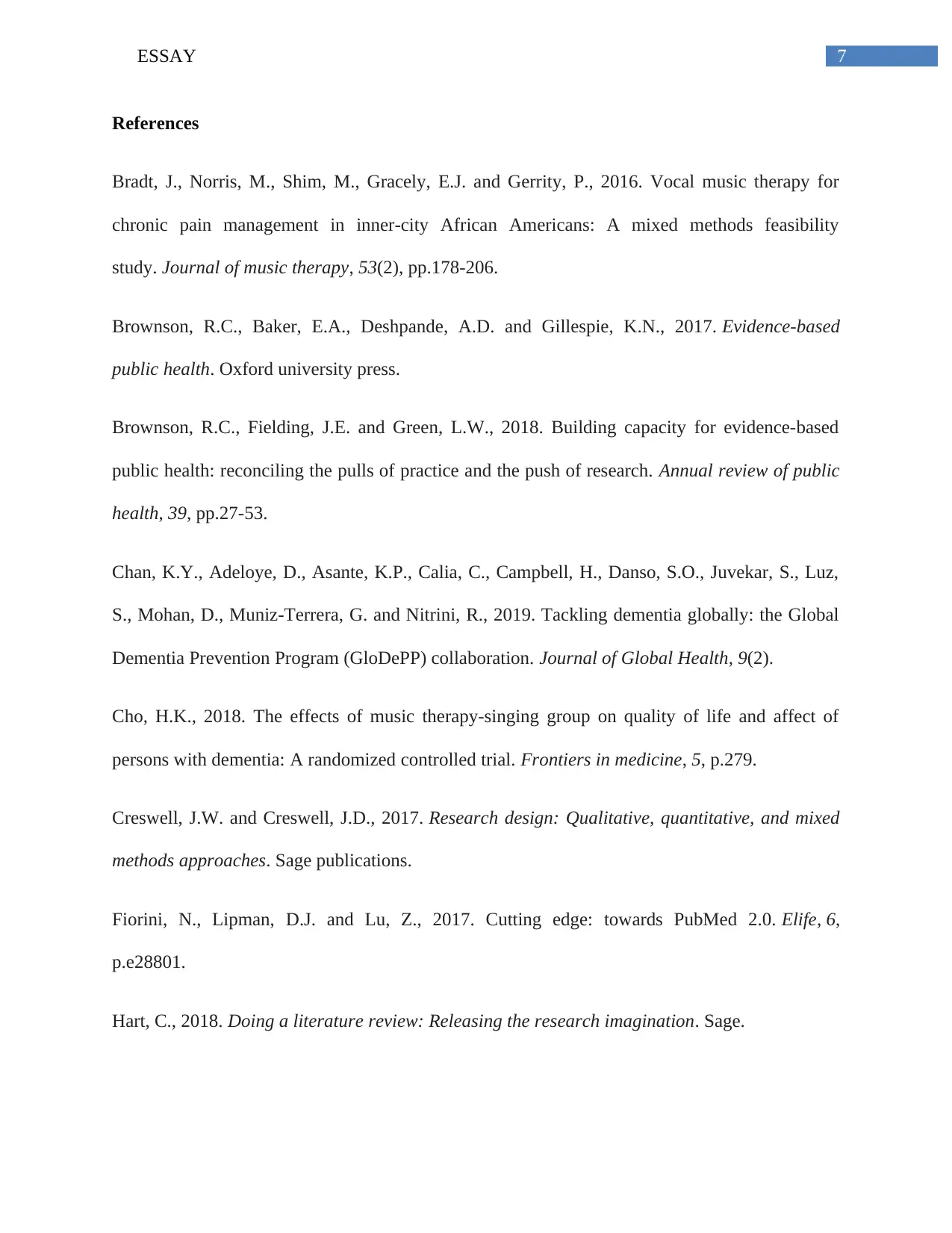
7ESSAY
References
Bradt, J., Norris, M., Shim, M., Gracely, E.J. and Gerrity, P., 2016. Vocal music therapy for
chronic pain management in inner-city African Americans: A mixed methods feasibility
study. Journal of music therapy, 53(2), pp.178-206.
Brownson, R.C., Baker, E.A., Deshpande, A.D. and Gillespie, K.N., 2017. Evidence-based
public health. Oxford university press.
Brownson, R.C., Fielding, J.E. and Green, L.W., 2018. Building capacity for evidence-based
public health: reconciling the pulls of practice and the push of research. Annual review of public
health, 39, pp.27-53.
Chan, K.Y., Adeloye, D., Asante, K.P., Calia, C., Campbell, H., Danso, S.O., Juvekar, S., Luz,
S., Mohan, D., Muniz-Terrera, G. and Nitrini, R., 2019. Tackling dementia globally: the Global
Dementia Prevention Program (GloDePP) collaboration. Journal of Global Health, 9(2).
Cho, H.K., 2018. The effects of music therapy-singing group on quality of life and affect of
persons with dementia: A randomized controlled trial. Frontiers in medicine, 5, p.279.
Creswell, J.W. and Creswell, J.D., 2017. Research design: Qualitative, quantitative, and mixed
methods approaches. Sage publications.
Fiorini, N., Lipman, D.J. and Lu, Z., 2017. Cutting edge: towards PubMed 2.0. Elife, 6,
p.e28801.
Hart, C., 2018. Doing a literature review: Releasing the research imagination. Sage.
References
Bradt, J., Norris, M., Shim, M., Gracely, E.J. and Gerrity, P., 2016. Vocal music therapy for
chronic pain management in inner-city African Americans: A mixed methods feasibility
study. Journal of music therapy, 53(2), pp.178-206.
Brownson, R.C., Baker, E.A., Deshpande, A.D. and Gillespie, K.N., 2017. Evidence-based
public health. Oxford university press.
Brownson, R.C., Fielding, J.E. and Green, L.W., 2018. Building capacity for evidence-based
public health: reconciling the pulls of practice and the push of research. Annual review of public
health, 39, pp.27-53.
Chan, K.Y., Adeloye, D., Asante, K.P., Calia, C., Campbell, H., Danso, S.O., Juvekar, S., Luz,
S., Mohan, D., Muniz-Terrera, G. and Nitrini, R., 2019. Tackling dementia globally: the Global
Dementia Prevention Program (GloDePP) collaboration. Journal of Global Health, 9(2).
Cho, H.K., 2018. The effects of music therapy-singing group on quality of life and affect of
persons with dementia: A randomized controlled trial. Frontiers in medicine, 5, p.279.
Creswell, J.W. and Creswell, J.D., 2017. Research design: Qualitative, quantitative, and mixed
methods approaches. Sage publications.
Fiorini, N., Lipman, D.J. and Lu, Z., 2017. Cutting edge: towards PubMed 2.0. Elife, 6,
p.e28801.
Hart, C., 2018. Doing a literature review: Releasing the research imagination. Sage.
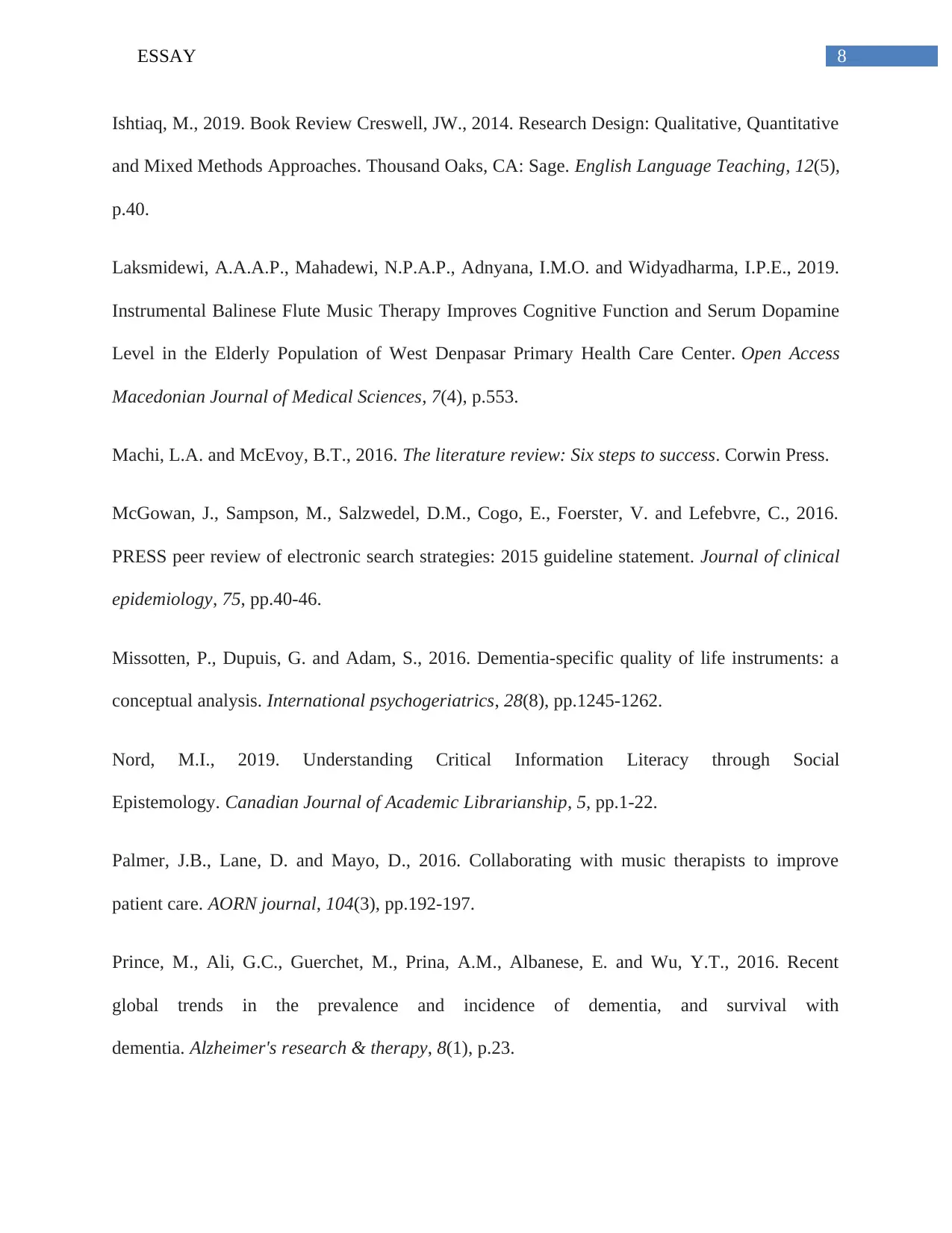
8ESSAY
Ishtiaq, M., 2019. Book Review Creswell, JW., 2014. Research Design: Qualitative, Quantitative
and Mixed Methods Approaches. Thousand Oaks, CA: Sage. English Language Teaching, 12(5),
p.40.
Laksmidewi, A.A.A.P., Mahadewi, N.P.A.P., Adnyana, I.M.O. and Widyadharma, I.P.E., 2019.
Instrumental Balinese Flute Music Therapy Improves Cognitive Function and Serum Dopamine
Level in the Elderly Population of West Denpasar Primary Health Care Center. Open Access
Macedonian Journal of Medical Sciences, 7(4), p.553.
Machi, L.A. and McEvoy, B.T., 2016. The literature review: Six steps to success. Corwin Press.
McGowan, J., Sampson, M., Salzwedel, D.M., Cogo, E., Foerster, V. and Lefebvre, C., 2016.
PRESS peer review of electronic search strategies: 2015 guideline statement. Journal of clinical
epidemiology, 75, pp.40-46.
Missotten, P., Dupuis, G. and Adam, S., 2016. Dementia-specific quality of life instruments: a
conceptual analysis. International psychogeriatrics, 28(8), pp.1245-1262.
Nord, M.I., 2019. Understanding Critical Information Literacy through Social
Epistemology. Canadian Journal of Academic Librarianship, 5, pp.1-22.
Palmer, J.B., Lane, D. and Mayo, D., 2016. Collaborating with music therapists to improve
patient care. AORN journal, 104(3), pp.192-197.
Prince, M., Ali, G.C., Guerchet, M., Prina, A.M., Albanese, E. and Wu, Y.T., 2016. Recent
global trends in the prevalence and incidence of dementia, and survival with
dementia. Alzheimer's research & therapy, 8(1), p.23.
Ishtiaq, M., 2019. Book Review Creswell, JW., 2014. Research Design: Qualitative, Quantitative
and Mixed Methods Approaches. Thousand Oaks, CA: Sage. English Language Teaching, 12(5),
p.40.
Laksmidewi, A.A.A.P., Mahadewi, N.P.A.P., Adnyana, I.M.O. and Widyadharma, I.P.E., 2019.
Instrumental Balinese Flute Music Therapy Improves Cognitive Function and Serum Dopamine
Level in the Elderly Population of West Denpasar Primary Health Care Center. Open Access
Macedonian Journal of Medical Sciences, 7(4), p.553.
Machi, L.A. and McEvoy, B.T., 2016. The literature review: Six steps to success. Corwin Press.
McGowan, J., Sampson, M., Salzwedel, D.M., Cogo, E., Foerster, V. and Lefebvre, C., 2016.
PRESS peer review of electronic search strategies: 2015 guideline statement. Journal of clinical
epidemiology, 75, pp.40-46.
Missotten, P., Dupuis, G. and Adam, S., 2016. Dementia-specific quality of life instruments: a
conceptual analysis. International psychogeriatrics, 28(8), pp.1245-1262.
Nord, M.I., 2019. Understanding Critical Information Literacy through Social
Epistemology. Canadian Journal of Academic Librarianship, 5, pp.1-22.
Palmer, J.B., Lane, D. and Mayo, D., 2016. Collaborating with music therapists to improve
patient care. AORN journal, 104(3), pp.192-197.
Prince, M., Ali, G.C., Guerchet, M., Prina, A.M., Albanese, E. and Wu, Y.T., 2016. Recent
global trends in the prevalence and incidence of dementia, and survival with
dementia. Alzheimer's research & therapy, 8(1), p.23.
⊘ This is a preview!⊘
Do you want full access?
Subscribe today to unlock all pages.

Trusted by 1+ million students worldwide
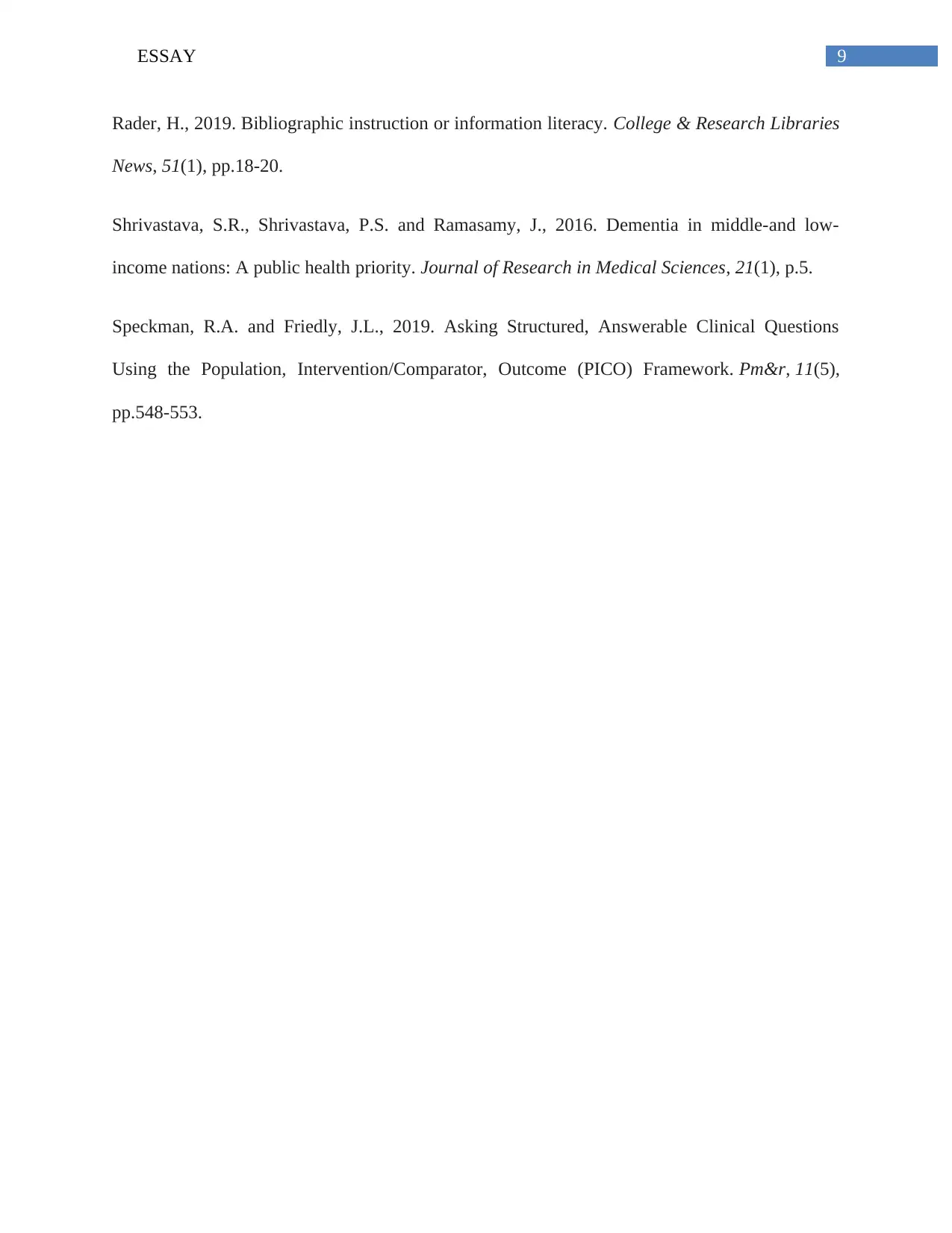
9ESSAY
Rader, H., 2019. Bibliographic instruction or information literacy. College & Research Libraries
News, 51(1), pp.18-20.
Shrivastava, S.R., Shrivastava, P.S. and Ramasamy, J., 2016. Dementia in middle-and low-
income nations: A public health priority. Journal of Research in Medical Sciences, 21(1), p.5.
Speckman, R.A. and Friedly, J.L., 2019. Asking Structured, Answerable Clinical Questions
Using the Population, Intervention/Comparator, Outcome (PICO) Framework. Pm&r, 11(5),
pp.548-553.
Rader, H., 2019. Bibliographic instruction or information literacy. College & Research Libraries
News, 51(1), pp.18-20.
Shrivastava, S.R., Shrivastava, P.S. and Ramasamy, J., 2016. Dementia in middle-and low-
income nations: A public health priority. Journal of Research in Medical Sciences, 21(1), p.5.
Speckman, R.A. and Friedly, J.L., 2019. Asking Structured, Answerable Clinical Questions
Using the Population, Intervention/Comparator, Outcome (PICO) Framework. Pm&r, 11(5),
pp.548-553.
Paraphrase This Document
Need a fresh take? Get an instant paraphrase of this document with our AI Paraphraser
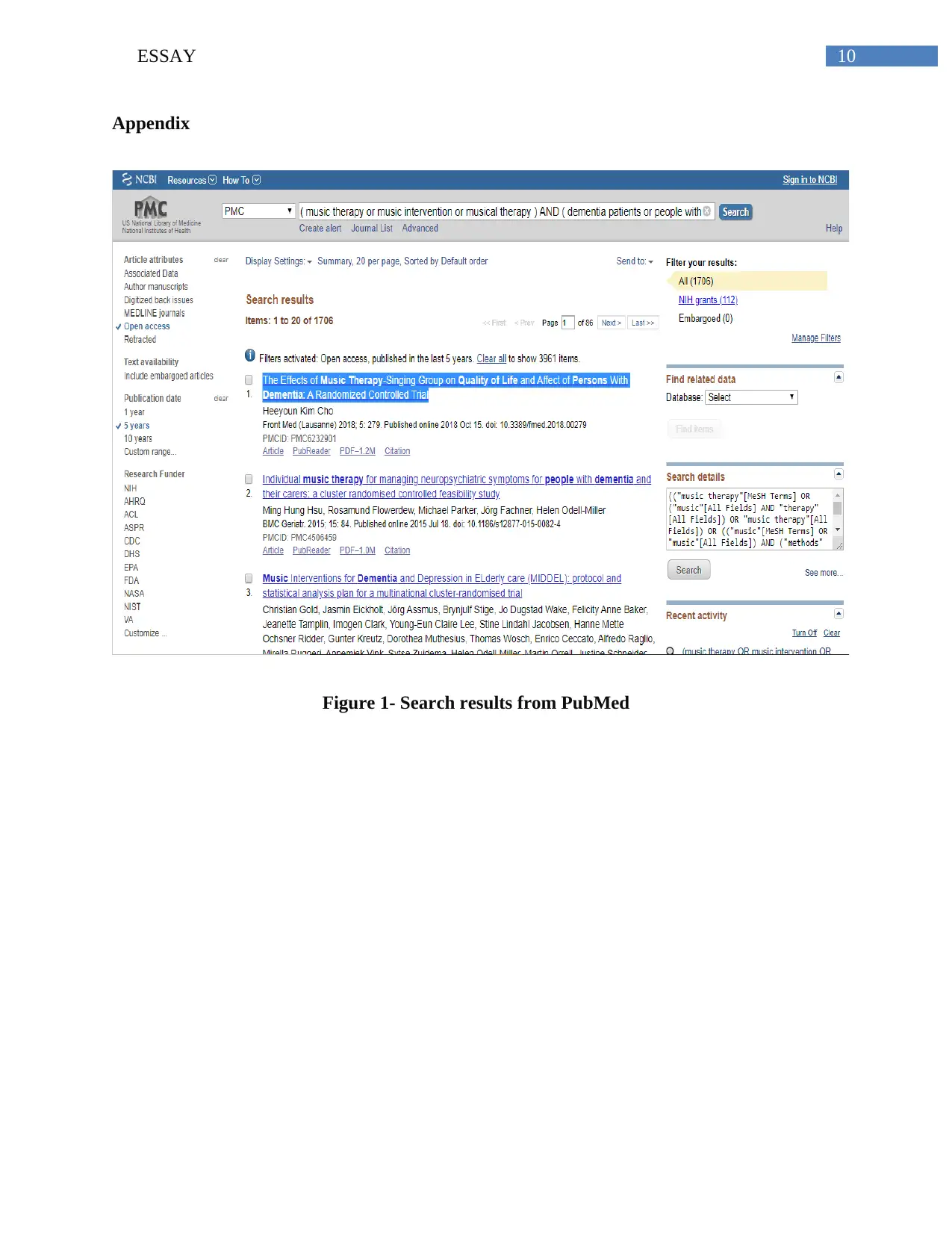
10ESSAY
Appendix
Figure 1- Search results from PubMed
Appendix
Figure 1- Search results from PubMed
1 out of 11
Related Documents
Your All-in-One AI-Powered Toolkit for Academic Success.
+13062052269
info@desklib.com
Available 24*7 on WhatsApp / Email
![[object Object]](/_next/static/media/star-bottom.7253800d.svg)
Unlock your academic potential
Copyright © 2020–2025 A2Z Services. All Rights Reserved. Developed and managed by ZUCOL.





